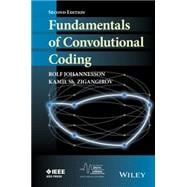
What is included with this book?
Rolf Johannesson is Professor Emeritus of Information Theory at Lund University, Sweden, and a Fellow of the IEEE. He was awarded the honor of Professor, honoris causa, from the Institute for Information Transmission Problems, Russian Academy of Sciences, and elected member of the Royal Swedish Academy of Engineering Sciences. Dr. Johannesson's research interests include information theory, coding theory, and cryptography.
Kamil Sh. Zigangirov is Professor Emeritus of Telecommunication Theory at Lund University, Sweden, and a Fellow of the IEEE. He is widely published in the areas of information theory, coding theory, mathematical statistics, and detection theory. Dr. Zigangirov is the inventor of the stack algorithm for sequential decoding and the co-inventor of the LDPC convolutional codes.
Preface xi
Acknowledgement xiv
1 Introduction 1
1.1 Why error control? 1
1.2 Block codes—a primer 8
1.3 Codes on graphs 21
1.4 A first encounter with convolutional codes 28
1.5 Block codes versus convolutional codes 35
1.6 Capacity limits and potential coding gain revisited 36
1.7 Comments 39
Problems 41
2 Convolutional encoders—Structural properties 49
2.1 Convolutional codes and their encoders 49
2.2 The Smith form of polynomial convolutional generator matrices 58
2.3 Encoder inverses 67
2.4 Encoder and code equivalences 76
2.5 Basic encoding matrices 79
2.6 Minimalbasic encoding matrices 82
2.7 Minimal encoding matrices and minimal encoders 90
2.8 Canonical encoding matrices* 109
2.9 Minimality via the invariantfactor theorem* 127
2.10 Syndrome formers and dual encoders 131
2.11 Systematic convolutional encoders 139
2.12 Some properties of generator matrices—an overview 150
2.13 Comments 150
Problems 152
3 Distance properties of convolutional codes 161
3.1 Distance measures—a first encounter 161
3.2 Active distances 171
3.3 Properties of convolutional codes via the active distances 179
3.4 Lower bound on the distance profile 181
3.5 Upper bounds on the free distance 186
3.6 Timevarying convolutional codes 191
3.7 Lower bound on the free distance 195
3.8 Lower bounds on the active distances* 200
3.9 Distances of cascaded concatenated codes* 207
3.10 Path enumerators 213
3.11 Comments 220
Problems 221
4 Decoding of convolutional codes 225
4.1 The Viterbi algorithm revisited 226
4.2 Error bounds for timeinvariant convolutional codes 235
4.3 Tighter error bounds for timeinvariant convolutional codes 250
4.4 Exact bit error probability for Viterbi decoding 255
4.5 The BCJR algorithm for APP decoding 271
4.6 The oneway algorithm for APP decoding 283
4.7 A simple upper bound on the bit error probability for extremely noisy channels 288
4.8 Tailbiting trellises 293
4.9 Decoding of tailbiting codes 302
4.10 BEAST decoding of tailbiting codes 308
4.11 Comments 323
Problems 324
5 Random ensemble bounds for decoding error probability 333
5.1 Upper bounds on the output error burst lengths 333
5.2 Bounds for periodically timevarying convolutional codes 345
5.3 Lower error probability bounds for convolutional codes 355
5.4 General bounds for timevarying convolutional codes 363
5.5 Bounds for finite backsearch limits 375
5.6 Quantization of channel outputs 379
5.7 Comments 384
Problems 384
6 List decoding 387
6.1 List decoding algorithms 388
6.2 List decoding—performance 391
6.3 The list minimum weight 397
6.4 Upper bounds on the probability of correct path loss 407
6.5 Lower bound on the probability of correct path loss 416
6.6 Correct path loss for timeinvariant convolutional codes 418
6.7 Comments 422
Problems 423
7 Sequential decoding 425
7.1 The Fano metric 426
7.2 The stack algorithm 431
7.3 The Fano algorithm 433
7.4 The Creeper algorithm* 436
7.5 Simulations 448
7.6 Computational analysis of the stack algorithm 450
7.7 Error probability analysis of the stack algorithm 460
7.8 Analysis of the Fano algorithm 471
7.9 Analysis of Creeper* 477
7.10 Comments 480
Problems 481
8 Lowdensity paritycheck codes 485
8.1 LDPC block codes 486
8.2 LDPC convolutional codes 496
8.3 Block and convolutional permutors 508
8.4 Lower bounds on distances of LDPC codes 517
8.5 Iterative decoding of LDPC codes 529
8.6 Iterative limits and thresholds 538
8.7 Braided block codes* 553
8.8 Comments 562
Problems 562
9 Turbo coding 567
9.1 Parallel concatenation of two convolutional codes 567
9.2 Distance bounds of turbo codes 570
9.3 Parallel concatenation of three and more convolution codes 573
9.4 Iterative decoding of turbo codes 582
9.5 Braided convolutional codes* 586
9.6 Comments 591
Problems 591
10 Convolutional codes with good distance properties 593
10.1 Computing the Viterbi spectrum using FAST 594
10.2 The magnificient BEAST 598
10.3 Some classes of rate R = 1=2 convolutional codes 604
10.4 Low rate convolutional codes 608
10.5 High rate convolutional codes 621
10.6 Tailbiting trellis encoders 622
10.7 Comments 622
Appendix A: Minimal encoders 627
Appendix B: Wald’s identity 635
References 647
Index 659
The New copy of this book will include any supplemental materials advertised. Please check the title of the book to determine if it should include any access cards, study guides, lab manuals, CDs, etc.
The Used, Rental and eBook copies of this book are not guaranteed to include any supplemental materials. Typically, only the book itself is included. This is true even if the title states it includes any access cards, study guides, lab manuals, CDs, etc.